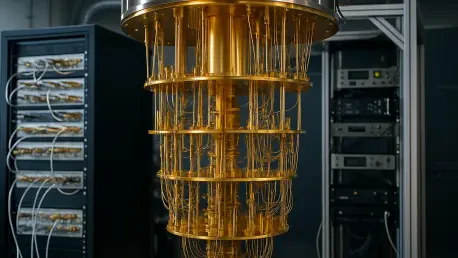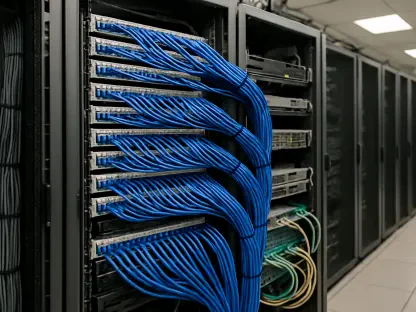In an era where computational limits are being pushed beyond imagination, quantum computing stands as a beacon of transformative potential, promising to solve problems that classical systems can only dream of tackling, such as the sheer complexity of designing new materials or cracking cryptographic codes—tasks that could take traditional computers millennia but might be resolved in mere hours with quantum technology. Microsoft, a titan in the tech industry, has positioned itself at the forefront of this revolution through its ambitious quantum computing initiatives, particularly with its largest hub in Lyngby, Denmark. This review delves into the intricacies of Microsoft’s quantum endeavors, exploring the innovations, challenges, and real-world implications of their cutting-edge work.
Pioneering Quantum Ambitions in Denmark
Microsoft’s quantum computing program is not merely a research project but a strategic mission to redefine technological boundaries. The company’s largest quantum site in Lyngby, Denmark, serves as a global epicenter for this vision, leveraging the region’s deep-rooted connection to quantum mechanics, tracing back to the legacy of Niels Bohr. This location is no coincidence; Denmark’s academic prowess, bolstered by institutions like the DTU and the Niels Bohr Institute, provides fertile ground for innovation and collaboration.
The initiative aligns seamlessly with the European Commission’s broader strategy to establish Europe as a leader in quantum technology by 2030. Microsoft’s commitment in Denmark is a testament to its goal of developing the most powerful quantum systems, with a target to operationalize groundbreaking technology within the next few years. This hub is set to become a cornerstone for advancing security protocols, research capabilities, and next-generation tech solutions on a global scale.
Beyond geographic and academic advantages, the Lyngby facility represents a melding of corporate ambition with regional expertise. It is designed to attract top European talent and foster training programs, ensuring that the quantum workforce of tomorrow is prepared today. This strategic positioning underscores Microsoft’s intent to not only innovate but also to build a sustainable ecosystem for quantum advancements.
Technological Innovations Driving Quantum Progress
Breakthroughs with Topological Qubits and Majorana 1 Chip
At the heart of Microsoft’s quantum strategy lies its pioneering work on topological qubits, a technology poised to redefine the stability and scalability of quantum systems. Unlike traditional qubits, which are highly susceptible to errors, topological qubits offer a pathway to fault-tolerant computing, a critical milestone for practical applications. The Majorana 1 chip, a flagship innovation, is engineered to support millions of qubits on a single platform, marking a significant leap toward overcoming current computational bottlenecks.
The technical sophistication of the Majorana 1 chip cannot be overstated. By harnessing unique quantum states, it aims to minimize errors that plague other quantum architectures, potentially outpacing competitors in the race for reliable systems. The Lyngby facility plays a pivotal role in this development, housing an AI-supported hardware lab capable of manufacturing core components on-site, thus accelerating the iterative process of design and testing.
This innovation is not just about raw power but about creating a foundation for sustainable quantum progress. The ability to scale up to millions of qubits could unlock solutions to complex problems in fields like cryptography and material science, positioning Microsoft as a leader in delivering quantum technology that is both robust and practical for widespread adoption.
Collaboration on the Magne Quantum Supercomputer
Another cornerstone of Microsoft’s quantum portfolio is its partnership with Atom Computing on the Magne project, a quantum supercomputer slated for operation by the end of 2026. This initiative represents a bold step toward transitioning quantum computing from theoretical exploration to tangible, real-world utility. The Magne system is designed to integrate cutting-edge hardware with advanced algorithms, targeting challenges that require unprecedented computational power.
The collaboration highlights a shared vision of making quantum technology accessible for practical applications. By combining Microsoft’s expertise in scalable systems with Atom Computing’s innovative approaches, the project aims to set new benchmarks in performance and reliability. The Lyngby hub will serve as a critical testing ground for this supercomputer, ensuring that its development remains aligned with global industry needs.
What sets the Magne project apart is its focus on bridging the gap between research and deployment. This endeavor is expected to catalyze advancements in sectors ranging from pharmaceuticals to cybersecurity, offering a glimpse into how quantum computing could reshape entire industries. Microsoft’s investment in this collaboration underscores its commitment to not just leading but also democratizing quantum innovation.
Current Trends and Strategic Expansions
Microsoft’s quantum efforts are evolving rapidly, with the Lyngby facility emerging as a global hub for research and development. Recent expansions at the site include enhanced infrastructure for AI-driven hardware labs, which streamline the production of critical quantum components. This integration of artificial intelligence into the manufacturing process is a notable trend, reflecting broader industry shifts toward leveraging machine learning for optimizing quantum hardware design.
Additionally, the focus on scalability remains a priority, as Microsoft aligns its strategies with the growing demand for real-world quantum solutions. The company is actively exploring ways to integrate quantum systems into existing technological frameworks, ensuring compatibility and ease of adoption. These efforts are supported by partnerships with academic institutions in Denmark, fostering a collaborative environment that drives innovation at an accelerated pace.
The strategic importance of these developments extends beyond technical achievements. By centralizing its quantum operations in Denmark, Microsoft is cultivating a talent pipeline and reinforcing Europe’s position in the global quantum race. This alignment with regional goals and industry trends positions the company to address emerging challenges and capitalize on opportunities in this dynamic field.
Real-World Implications and Applications
The potential applications of Microsoft’s quantum technology span a wide array of industries, promising to solve problems previously deemed intractable. In the realm of cybersecurity, quantum systems could revolutionize encryption methods, rendering current protocols obsolete while establishing new standards for data protection. This capability is particularly crucial in an age where digital threats are becoming increasingly sophisticated.
Beyond security, the impact on scientific research is profound. Quantum computing could accelerate drug discovery by simulating molecular interactions at an unprecedented scale, potentially shaving years off development timelines. Similarly, advancements in material science could lead to the creation of stronger, more sustainable materials, addressing global challenges like energy efficiency and climate change.
Unique use cases are also emerging from the Lyngby hub’s innovations. For instance, the ability to model complex systems could transform logistics and supply chain management, optimizing routes and reducing costs on a massive scale. These applications highlight the versatility of Microsoft’s quantum initiatives, demonstrating their potential to influence diverse sectors and drive systemic change.
Challenges in the Quantum Landscape
Despite the promise of quantum computing, Microsoft faces significant hurdles in realizing its full potential. Achieving fault tolerance remains a formidable technical challenge, as even minor errors can derail computations in quantum systems. The development of the Majorana 1 chip aims to address this, but the path to true error-free computing is still under exploration, requiring sustained research and experimentation.
Scalability poses another obstacle, as integrating millions of qubits into a cohesive, functional system is a complex endeavor. Market and regulatory barriers also loom large, with uncertainties around standardization and intellectual property rights potentially slowing progress. Microsoft’s investment in the Lyngby facility and strategic partnerships are steps toward mitigating these issues, but the road ahead remains intricate.
Moreover, the high cost of quantum research and infrastructure could limit accessibility, creating disparities in adoption across industries and regions. Addressing these challenges will require not only technological innovation but also policy advocacy and collaborative frameworks. Microsoft’s ongoing efforts to build an ecosystem in Denmark reflect a proactive approach to navigating this multifaceted landscape.
Future Horizons in Quantum Technology
Looking ahead, Microsoft’s quantum initiatives hold the promise of transformative breakthroughs, particularly in the realm of topological qubits and supercomputing. The continued development of the Majorana 1 chip could redefine fault tolerance, paving the way for systems that are both powerful and reliable. By 2027, significant milestones in this area are anticipated, potentially setting new industry standards.
The long-term impact on society and industries is equally compelling. Quantum computing could become a cornerstone of technological infrastructure, influencing everything from healthcare to finance. Microsoft’s role in shaping this future is pivotal, especially as it aligns with European goals to lead the global quantum landscape by the end of the decade, fostering innovation on a continental scale.
Exploration of hybrid systems, combining quantum and classical computing, is another area of potential growth. Such integration could ease the transition for industries adopting quantum solutions, ensuring broader applicability. Microsoft’s strategic focus on Denmark as a hub for these advancements positions it to influence the trajectory of quantum technology profoundly in the coming years.
Final Thoughts on a Quantum Legacy
Reflecting on Microsoft’s journey in quantum computing, the strides made through the Lyngby hub in Denmark mark a significant chapter in technological history. The innovations in topological qubits and the collaborative Magne project showcase a blend of ambition and pragmatism that sets a high bar for the industry. These efforts demonstrate a clear path toward overcoming longstanding barriers in quantum systems.
As a next step, stakeholders across sectors should focus on fostering partnerships that bridge the gap between research and application, ensuring that quantum advancements translate into tangible benefits. Investment in talent development and accessible infrastructure emerges as critical actions to democratize this technology. Microsoft’s leadership in this domain provides a blueprint for how such challenges can be met with strategic vision.
Moreover, the industry needs to prioritize frameworks for ethical and regulatory considerations to guide quantum deployment responsibly. Engaging with policymakers and global tech communities offers a way forward to address potential disparities in access and impact. Microsoft’s pioneering work lays a foundation, but the collective effort of innovators worldwide is essential to fully realize the quantum revolution.









